Trek Culture Review: Star Trek Starships 'Recent' Releases

We're super stoked every time we see a box in the mail from Eaglemoss, the people responsible for the Star Trek Starships Collection, but this time the time between shipments seemed to be quicker than normal. We'd love to blame that on an exciting temporal anomaly adventure but the reality is that we've just been plain old busy. But hey, how is it not cool when the outcome of busy-ness is that you get to open 3 shipments of Star Trek collectibles all at once? It was totally Trek-mas in July September. Check out their website to sign up for a subscription of your very own.
Anyway, as usual, we loved every second of opening and "assembling" our ships. That's one of those things I personally like to savor. Examining each ship's detail is a blast. Don't tell anybody, but when I happen to be opening them when no one else is around, they even go out for a little "test-flight" around the room...with corresponding "vroom vroom" sound effects (provided by me, of course). Remember...mum's the word on that one.
Helpful Tip for attaching your ship to its stand: Check out the inside cover of your ship's book, and you will find a few photos labeled "Stand Assembly." These will show you how to correctly place the ship on the stand.
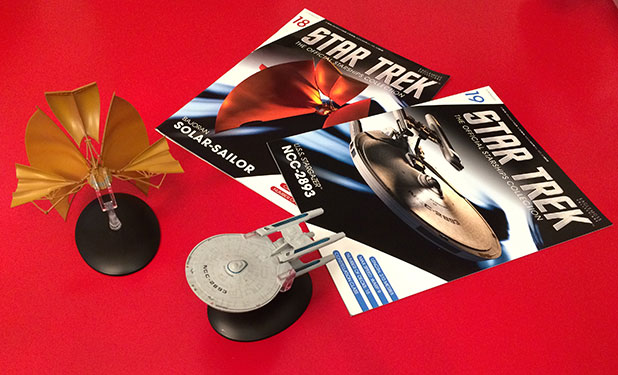
As always, each ship comes with a book that is a wealth of knowledge and little know facts about that particular ship. We liked wetting your appetite with a snippet from each ship's book, last time, so we're going to do that again. Fasten your seatbelts, because this time you get to read about not just two...but six ships, in total.
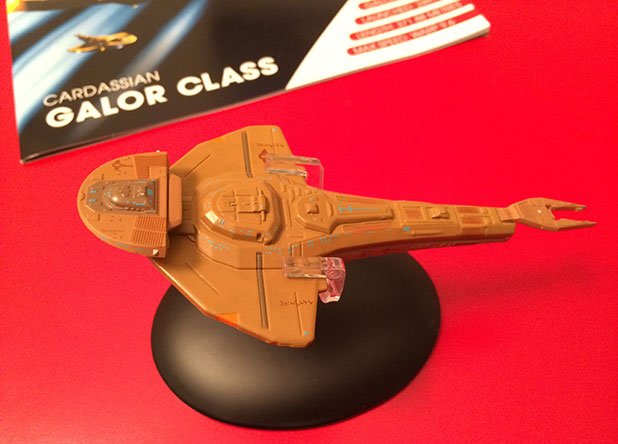
Issue #14: Cardassian Galor Class
Galor-class warships were the most common vessels in the Cardassian fleet in the latter half of the 24th century. They were 371.88 metres long and normally carried a crew of around 600 personnel. Each ship was commanded by a gul, a rank equivalent to a Starfleet captain, and each gul was usually served by two glinns, a position analogous to a first officer.
Galor-class ships were powered by gas diffusion matter-antimatter engines. These were embedded within the 'wing' structures on either side of the main body and were capable of propelling the ships to speeds as high as warp 9.6.
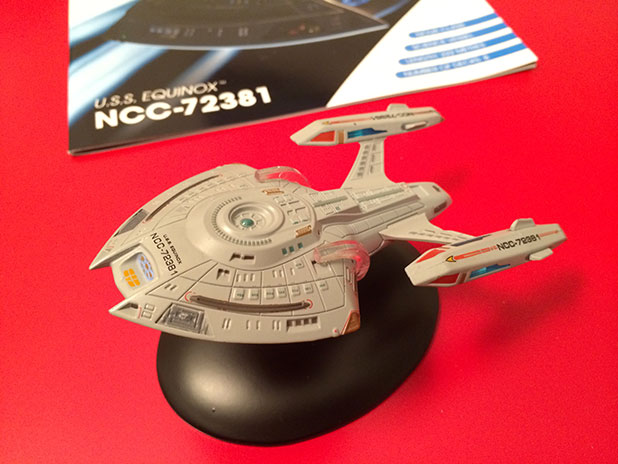
Issue #15: U.S.S. Equinox NCC-72381
The Nova-class U.S.S. Equinox was built at the Utopia Planitia Fleet Yards and was designed to function as a science and scout vessel, making it perfect for short-term planetary research and analysis rather than long-range tactical missions. As a result the Equinox had a top speed of only warp eight ad was fitted with minimal weaponry, although it was one of the first ships to be equipped with an Emergency Medical Hologram.
Measuring 221.74 metres in length with eight decks, the Equinox was a relatively small vessel. The Nova-class spaceframe was originally developed as part of the Defiant Pathfinder project which was established to deal with the Borg threat in the 2360s. However, when the defiant project took a different approach, the Nova prototype was reclassified as a science vessel.

Issue #16: Ferengi Marauder
The number-one goal in life for all Ferengi, superseding all other endeavours, was the pursuit of profit and the vast accumulation of wealth. To help further this aim, the Ferengi most commonly used D'Kora-class vessels, know collectively as Marauders, to travel to worlds in the Alpha and Gamma Quadrants to trade with them.
Marauders were, however, also sometimes used to attack other ships and colonies in order to steal technology or supplies, which the crew could then resell. In many ways the Ferengi were like pirates, using their Marauders to roam the Galaxy, hoping to come across weak or vulnerable targets that they could plunder.
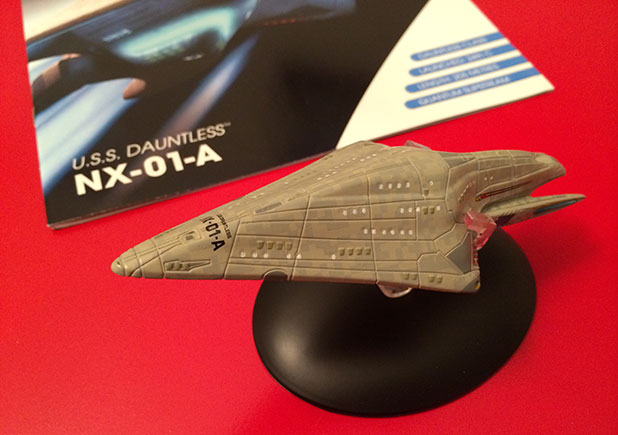
Issue #17: U.S.S. Dauntless NX-01-A
(possible spoiler alert) In mid-2374, the crew of the U.S.S.Voyager decoded a secret message that led them to the U.S.S. Dauntless NX-01-A. The ship appeared to be the most advanced starship ever developed by Starfleet, and to have been sent to the Delta Quadrant to provide Voyager's crew with a speedy means to return home. But, as they were to discover, the Dauntless was part of an elaborate trap set by an alien known as Arturis, in order to exact revenge on Captain Janeway for her part in helping the Borg defeat Species 8472. The Borg's victory had contributed to Arturis' people being almost completely wiped out. He was consumed by his desire for vengeance and faked the message in the hope of luring Janeway's crew onto the Dauntless, which instead of taking them to Earth, would deliver them to the Borg.
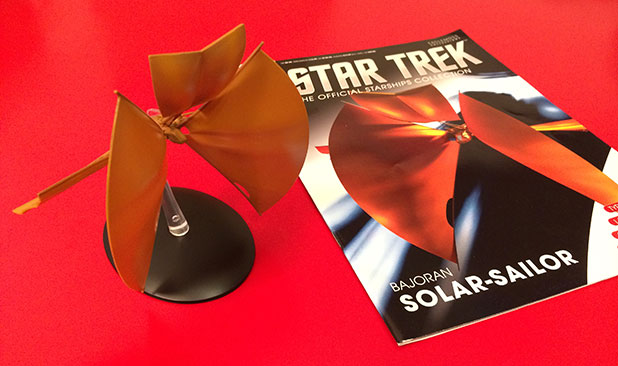
(This ship is one of my favorites, not to mention one of the coolest looking, so I decided it needed several viewpoints. The Front view is above and the Rear view is below.)
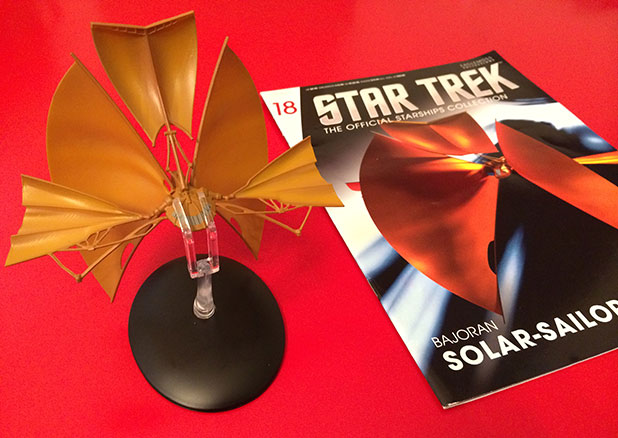
Issue #18: Bajoran Solar-Sailor
Bajoran solar-sailor vessels were ancient spacecraft that used enormous reflective sails to harness the power of light pressure from Bajor's sun to provide propulsion, much in the same way as a sailboat does with the wind.
More than 800 years ago, when humans were first sailing across oceans, the Bajorans used these solor-sailor vessels, or lightships, to explore their star system. It was believed by some historians that these ancient vessels even managed to reach Cardassia in the neighbouring star system, but as the fragile ships were not designed for faster-than-light travel it was thought unlikely this was possible.
In 2371, Benjamin Sisko became fascinated by these ancient lightships after seeing blueprints for them while visiting the reopening of an old library on Bajor that had the most extensive collection of antiquities on the planet. He decided to use these plans to build an authentic replica of a solar-sailor vessel to see if it was spaceworthy.
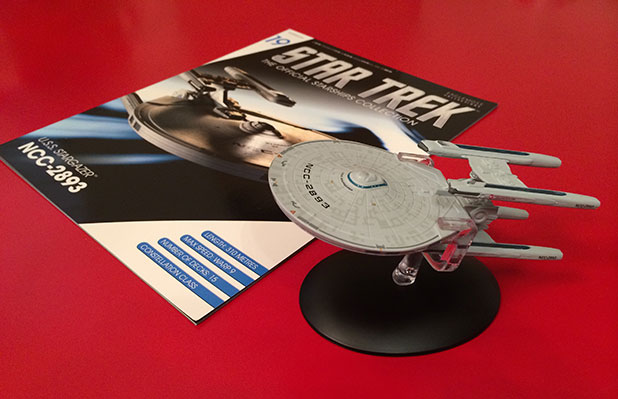
Issue #19: U.S.S. Stargazer NCC-2893
The Constellation-class U.S.S. Stargazer NCC-2893 was primarily designed for deep space exploration and defensive patrol duty. It was built at the San Francisco Fleet Yards on Earth and was in service from the early to mid-24th century.
The Stargazer was only slightly shorter than a Constitution-class vessel and its appearance resembled that of Miranda-class ships in that it did not have a secondary or engineering hull. Instead, its warp nacelles were attached to a spar at the rear of the saucer section.
Usually for a Starfleet vessel, the Constellation class was equipped with four warp nacelles; two were mounted on a pylon above the command saucer, and two hung below.
Don't forget to cruise on over to the Star Trek Starships website to sign up and begin a collection of your own.

